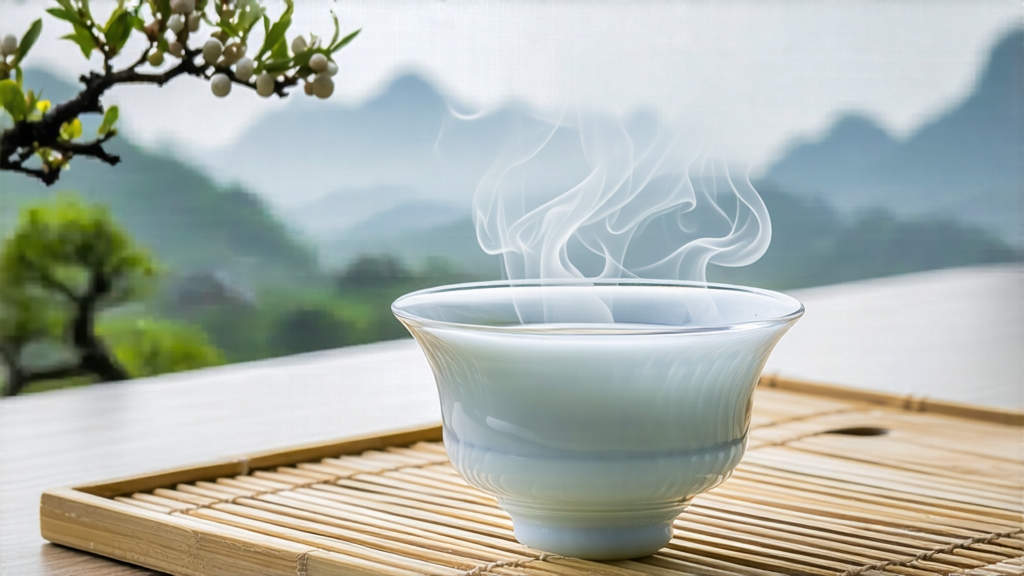
Among the six great families of Chinese tea, white tea is the least interventionist, the most willing to let leaf and time speak for themselves. Within that minimalist lineage, no expression is more revered than Bai Hao Yin Zhen—literally “White Hair Silver Needle”—a tea so visually ethereal that early European merchants mistook its downy buds for precious metal filings. Harvested only during a fleeting handful of spring mornings, Yin Zhen embodies the Chinese aesthetic ideal of “plain elegance”: ostensibly simple, yet inexhaustibly nuanced.
Historical whispers place Yin Zhen’s birth in the mist-locked mountains of northern Fujian during the late Song dynasty, but its documented fame begins with the Qing-era imperial tribute lists of 1796. Court chroniclers record that cakes of compressed Yin Zhen were couriered northward in camel caravans, wrapped in lotus leaves and stored beside winter melons to absorb their subtle perfume. When the last emperor abdicated in 1912, the tribute system collapsed; mountain farmers, no longer bound to Beijing, began to sell the loose buds to Fuzhou tea houses, and the modern identity of Silver Needle as a luxury commodity was born. Overseas, the 1960s counter-culture movement embraced it as “the champagne of teas,” cementing its global cachet.
True Bai Hao Yin Zhen is monovarietal: only the unopened, full-length buds of the Da Bai (Big White) tea tree, Fuding cultivar, qualify. Lesser “silver needles” from Yunnan or Guizhou may share the silhouette, but they lack the tight, fish-hook curve and the pearl-grey sheen that signals Fujian’s maritime cloud cover. Within Fuding itself, micro-terroirs matter. Buds plucked from the granite-derived, slightly acidic soils of Tai Lao Shan exhibit higher L-theanine, yielding a creamier liquor, while those from the red sandstone foothills of Pan Xi carry more catechins, translating into a brighter, quince-like snap. Connoisseurs speak of “three mists a day” valleys where morning, noon and evening fogs roll in succession, dehydrating the leaf surface while keeping internal moisture—nature’s own withering chamber.
The craft protocol has remained almost unchanged for two centuries. Picking begins when the morning thermometer hovers between 14 °C and 19 °C, the bud’s cuticle still taut with overnight dew. No fingernails are allowed; peasants use a gentle twirl-and-snap motion to avoid bruising. Within thirty minutes the buds are scattered on woven bamboo trays no thicker than one bud layer, then wheeled into a sun-drying yard oriented due east. Here they lie for no more than forty minutes, just long enough for the outer epidermis to lose its green cast and turn platinum. The trays are then transferred indoors to a curtained loft where they undergo 36–48 hours of passive withering, cooled only by mountain cross-breezes. No machines, no heat, no coercion—only the slow oxidation of endogenous enzymes, visible as the bud stem gradually tints coral. When a master judges that the moisture has fallen to 8–10 percent, a final charcoal bake at 40 °C finishes the tea, locking in a signature note of dried alfalfa and sweet hay. The entire cycle is lunar-calibrated; buds plucked on the waxing moon are said to age with greater complexity, a belief now corroborated by studies showing marginally higher polysaccharide content during that phase.
Western tutorials often recommend 80 °C water and two-minute infusions, but such parameters flatten Yin Zhen’s topography. The traditional Fujian approach, borrowed from aged-white-pharmacy customs, treats the buds as a re-hydrating living tissue. Begin with a tall, thin-walled glass; pre-warm it with 50 °C water, then quickly pour it out. Measure one gram of buds per 30 ml—roughly a small pinch that blankets the bottom in a single, loose layer. Bring your kettle to 85 °C, pause ten seconds, and descend the water in a high, thin stream so that each bud stands upright, buoyed by convection currents. The first infusion lasts a full five minutes; this extended contact coaxes the amino acids responsible for umami, yielding a liquor the color of